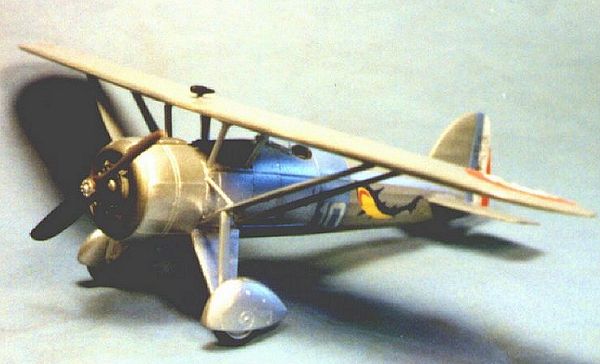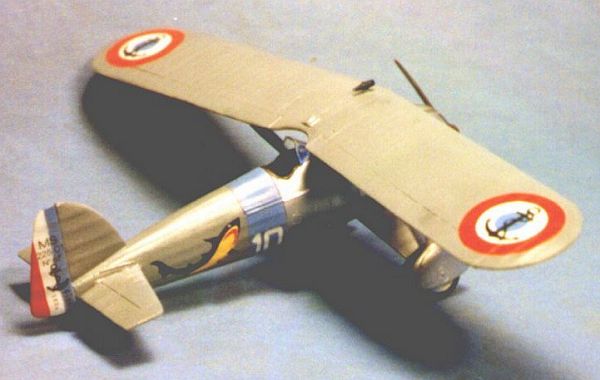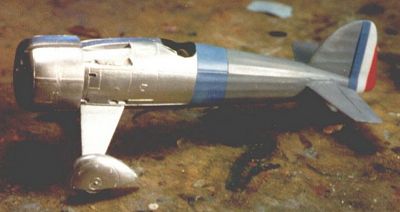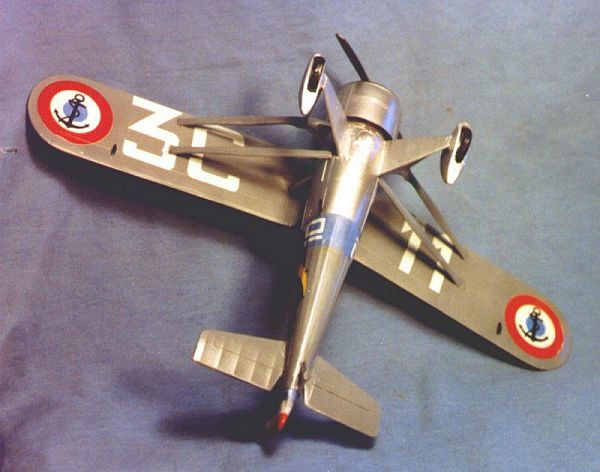
Battleaxe 1/48 MS.225
|
KIT # |
|
|
PRICE: |
$46.96 |
|
DECALS: |
Two Versions: EC 1/7 and Esc 3C-1 |
|
REVIEW : |
|
|
NOTES: |

|
HISTORY |
The parasol monoplane fighter was a World War I design, the outstanding example of which was the Fokker E.V/D.VIII. The design provided a pilot with downward visiblity hampered only by the struts anchoring the wing to the fuselage. Additionally, it was more stable than the low-wing monoplane, due to the center of lift being above the center of gravity. Following the war, however, the only country which continued to develop the parasol monoplane as a fighter was France. Morane-Saulnier, which had become well-known as one of the major producers of parasol monoplanes during the war, continued to be a major aeronautical supporter of the concept during the 1920s.
By the late 20s, the leadership of the Aviation Militaire saw that airframes were becoming too heavy for the available powerplants, and issued what was known as the "Jockey" specification, for "lightweight" fighters. Among the three designs submitted was the Morane-Saulnier M.S.221, which - though it had the lightest wing-loading - turned out to be the slowest of the three, due to such things as lack of a cowling for the radial engine and a very non-streamlined landing gear.
The entire "Jockey" program fell apart with the failure of any of the submitted designs to achieve the desired performance. Morane-Saulnier persisted with the basic design and came up with the M.S.223 and M.S.224, which still did not meet air force needs. Finally, in 1932, the M.S.225 was first flown. This had a streamlined landing gear and a full NACA low drag cowl for its 600 hp Jupiter radial, and top speed approaching 200 mph.
Fifty-five M.S.225C1 fighters (serials N500-N554) wre ordered in 1932 as interim equipment. These were completed and delivered during the first half of 1933, equipping the 7e Escadre of the newly-created Arm'ee de l'Air at Dijon. \ 12 additional M.S.225.C1s were ordered for the Aviation Maritime, equipping Escadrille 3C-1 at Hy`eres. Three MS 226's were completed as carrier-based fighters with arresting gear and were tested aboard "Hermes:" a similar model with folding wings was designated MS 227, for a total of 16 naval machines.
The excellent manouverability of the MS 225 is reflected in its adoption, after withdrawal from first-line fighter squadrons, by the celebrated "Patrouille de Dijon" aerobatic team, and also by the "Patrouille de l'Ecole de l'Air." In June 1934 an MS 225 flown by Michel D'Etroyat gained second place in the World Aerobatic Championships.
|
THE KIT |

"BattleAxe" is an outgrowth of the French J.M.G.T. company, which since the early 80s has been known for creating vacuforms of French aircraft subjects, following this in the 90s with a move to all-resin kits, and now into limited-run injection-molded plastic. This M.S.225C1 is the first kit released by BattleAxe since their multi-media F-84G. (Before you go running from the room screaming, it appears that they have learned their lessons from that kit.)
This is a fairly simple model, and appears well-engineered in terms of construction. The quality of the plastic molding is good; the surface detail reveals in its heaviness the kit's vacuform and cast-resin ancestry, but the deep engraving is acceptable under a coat of paint. The fabric effect on the fuselage, horizontal stabilizer and lower wing, is very accurate in its look; the vertical fin and the upper surface of the wing suffer from over-emphasized rib detail, but this can be sanded down easily, which makes the final look very acceptable.
|
CONSTRUCTION |
The basic construction is straightforward. The only difficulty I found was the discovery that if the cockpit interior is installed as originally created, it is very difficult to close the fuselage halves around it. The solution is to cut off all the internal structure ahead of the instrument panel and behind the seat; you can't see any of it anyway, and by so doing everything fits easily and the fuselage closes up with no problem. I held off attaching the wing until after the model had been painted and the decals applied.
|
PAINT & DECALS |
I chose to do the Aviation Maritime airplane, since it looked better than the alternative, with the large shark insignia on the aft fuselage. I painted the airplane overall Gunze-Sany H-337 "Blueish Grey," then painted the blue stripe and the rudder stripes. I masked off the forward part of the fuselage until I was ready to shoot a coat of Glosscote on the model, at which time I removed the masking and shot it all. this gave a painted surface for the SnJ aluminum polishing powder I was going to use for the forward fuselage. I polished this out to a high sheen (I could actually "shave in it" if I so desired!), applying it afterthe Glosscote had dried to the touch but was not completely cured, so that the powder would adhere to it and I would not have to dull the final sheen with a coat of sealer.
masked off the forward part of the fuselage until I was ready to shoot a coat of Glosscote on the model, at which time I removed the masking and shot it all. this gave a painted surface for the SnJ aluminum polishing powder I was going to use for the forward fuselage. I polished this out to a high sheen (I could actually "shave in it" if I so desired!), applying it afterthe Glosscote had dried to the touch but was not completely cured, so that the powder would adhere to it and I would not have to dull the final sheen with a coat of sealer.
The decals provided allow the modeler to make one of two different M.S.225C1 fighters - an Arm'ee de l'Air aircraft from Groupe Chasse I/7, or an aircraft of Escadrille 3C-1, the only Aviation Maritime unit to operate it. As stated above, I went with the naval aircraft because of the markings. The decals went on easily, curling up and looking like they might die under MicroSol, but the end result was they melted right down to the "painted on" look. I shot another coat of Glosscote over the rear fuselage and wing, and was ready to head for the home stretch.
The wing struts were assembled per the drawings and allowed to set up overnight. The wing went on these with no problem. The rigging of the airplane is very easy: an "x" between fore and aft main struts on both sides. I used my "high E" straightened guitar string method to rig the model and everything was complete.
|
CONCLUSIONS |

For a modeler who likes aircraft from The Golden Age, this kit is an important contribution to any collection, and the built-up model will look good sitting next to the Boeing P-12E and F4B-4, as well as a Hawker Fury. As with most JMGT products, the M.S.225 is not cheap. It is marketed by Squadron Mail Order for US$46.96, which means you must really want to have it. While more expensive than other limited-run kits, it provides good value for the money for the modeler who enjoys working in this period of aviation history, and is unlikely to appear in anyone else's kit catalogue.
If you have gotten tired of "one-oh-thingies" of the Second World War, but aren't ready yet to dive into the bird cages of the First World War, this model is a good first step into the eras when the airplanes were more interesting - and a bit more of a challenge for a modeler to recreate.
Copyright ModelingMadness.com. All rights reserved. No reproduction in part or in whole without express permission.
Back to Reviews Page 2016